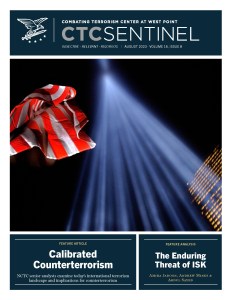From the Editor
As we enter a new era of calibrated counterterrorism 22 years after 9/11, in this month’s feature article senior analysts at the U.S. National Counterterrorism Center provide a unique window into the U.S. government’s continuing efforts to suppress international terrorism. NCTC director Christine Abizaid writes: “It is clear to me that Americans at home and abroad would be confronted with a more severe terrorism threat if it were not for the sustained and focused efforts of the entire U.S. CT community over the past 22 years. As we approach another 9/11 anniversary, I asked senior analysts from NCTC to share more with the public and academic community about the constant, behind-the-scenes work of CT professionals across the government. It is my hope that, through this product, others can gain a greater degree of insight into what this community regularly confronts in its mission to protect innocent civilians from persistent terrorist adversaries.”
In the second feature article, Amira Jadoon, Andrew Mines, and Abdul Sayed examine the enduring threat posed by Islamic State Khorasan (ISK). They write: “An analysis of ISK’s operations, outreach, and clashes with the Taliban indicate that the organization remains capable of strategic adaptation and is only broadening and deepening its influence in the region, posturing to become a truly regional organization. And while the Taliban have demonstrated some capacity in targeting ISK commanders, any security gains are unlikely to hold in the absence of sustained counter-ISK operations.”
With the Islamic State earlier this month announcing the appointment of its fifth caliph, Abu Hafs al-Hashimi al-Qurashi, Aymenn Al-Tamimi examines what little is known about the group’s recent paramount leaders. He writes: “Despite the fact that the group’s caliphs are now very much ‘men of the shadows,’ there is little evidence pointing to the prospect of the group’s fragmentation in Iraq, Syria, or elsewhere around the world, with the group’s affiliates seemingly willing to accept successor caliphs about whom little or nothing is publicly known.”
Lucas Webber and Alec Bertina profile the Russian Imperial Movement (RIM) and its paramilitary wing, the Russian Imperial Legion (RIL), tracing their involvement in the Ukraine conflict since 2014. They write: “With the Wagner Group’s resources waning, there may be an opportunity for RIM/RIL to deepen its involvement in Russia’s efforts in Ukraine. This could bolster the group’s recruitment, paramilitary capabilities, and thus increase the broader threat it poses. However, the organization may face sanctions in the future from the Russian state if the Kremlin continues to clamp down on Russian pro-war ultra-nationalist elements.”
Paul Cruickshank, Editor in Chief
 Skip to content
Skip to content

